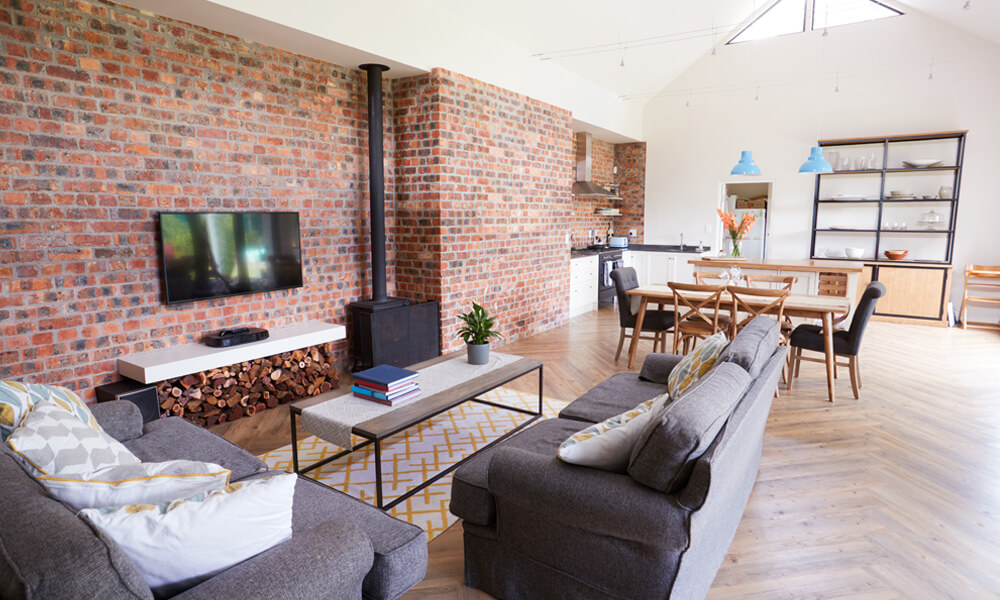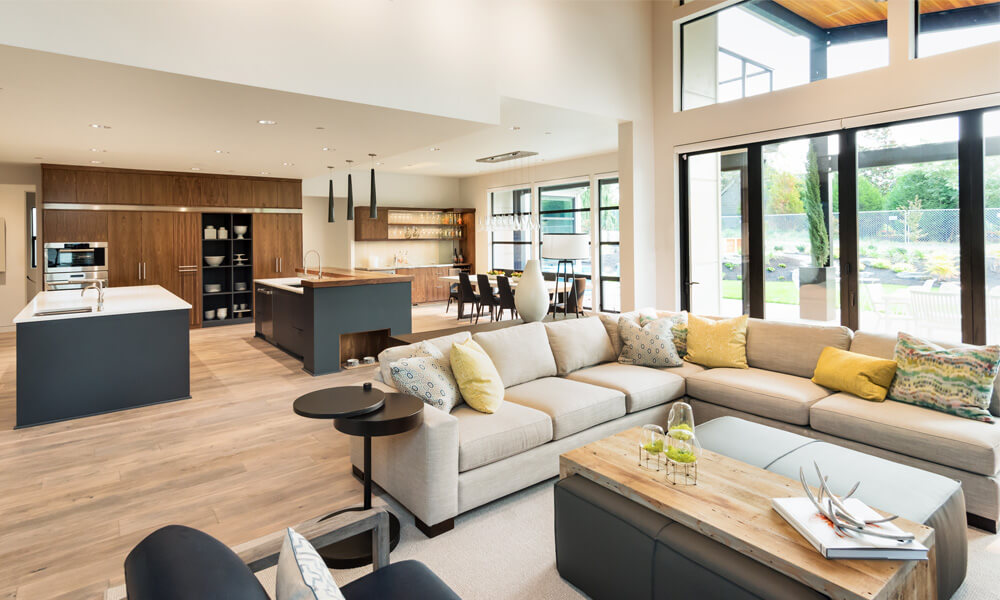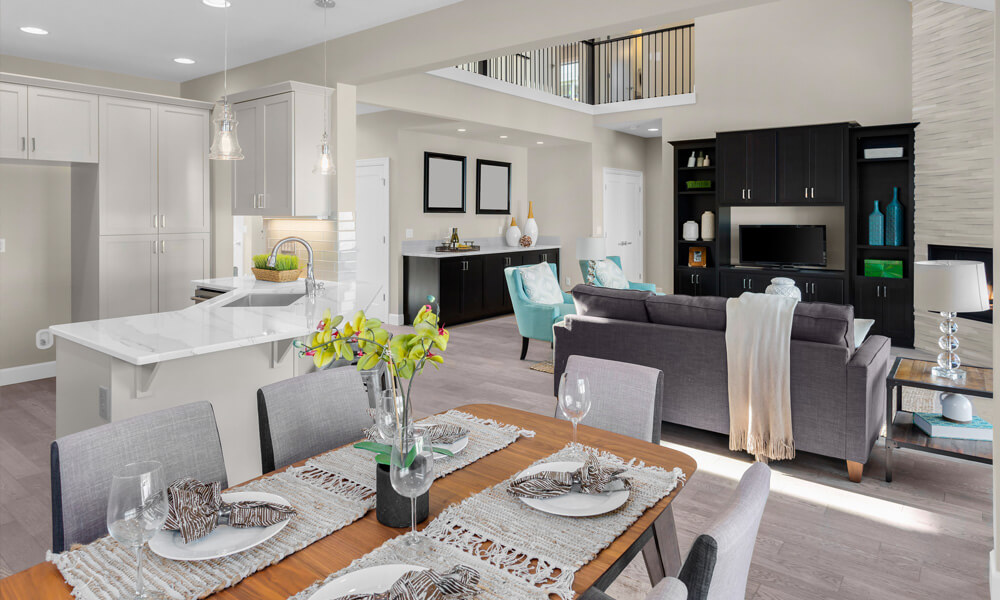What is An Open Floor Plan?
"An open floor plan is a part of a home that was designed to have the kitchen, dining, and living areas all in one room as a truly common space with no compartmentalizing walls," explains Joe Borress, Founder ofTri Star Electric & Automation.
An open-concept floor plan is typically two or three rooms that are an open space. This means that there are no walls or doorways separating the respective rooms. It's all just one big, multifunctional space.
The combination of the dining room and kitchen and living room is the most popular open-concept floor plan.
Why is Furniture Layout Important in an Open Plan Area?
The way in which you arrange furniture in your open-concept space is very important and has a huge impact on the feel and overall usability of the room. "With less wall separations, you'll need to think of how you and your family will function in the space," explains James Stanley, Founder & CEO,ofJames Stanley NY.
How you arrange furniture will also impact how your room feels. Does it feel crowded and like there's too much going on? Does it feel sparse and empty? Does the room feel warm and inviting, or does it feel cold and like a showroom?
Finally, does the room feel like one big room? Or does it feel like a few different rooms in one? How you decide to arrange furniture will affect whether or not your open-concept space feels cohesive.
Plan Ahead
Before you start buying and bookmarking pages in furniture catalogs, you need to come up with a game plan. Jumping headfirst and buying the first pieces of furniture you like is an easy way to be become overwhelmed and lose your way. Start by deciding what function your room is going to serve.
If you want to turn your open concept space into a dining room and living room, then you know roughly what furniture you'll need and can start to plan how the two spaces will work together.
According to James Stanley, "Less is more" when thinking about picking furniture for an open plan room. "Select pieces you are sure you want in the space," he adds.
When you're in the planning phase, it's also important that you take stock of the furniture you already have. Think about what you'll keep, and what are you'll get rid of. You should also consider how much space you have and how to best utilize it — you don't want to buy the wrong sized furniture and have a crowded and uncomfortable room.
"Scale-out the area with your furnishings before you buy and place it," suggests Stanley — who advises that you use blue painter's tape to block out the places you plan to have your furniture to see how it will all fit together.
8 Ideas for Arranging furniture in an Open Floor Plan
So how do you actually plan out open concept living spaces? Here are eight ideas.
1. Create Zones With Area Rugs
You can use an area rug as an anchor point when arranging furniture. An area rug is a simple way to tie a room together and make all the space seem smaller and more manageable.
Different area rugs in separate spaces can be used to define each area. For example, you could have a rug for your dining room that sites under the dining table and a rug for your family room area.

Joe Borress explains, "Distinguishing between formal dining, informal/kitchen dining, and living/entertainment spaces is key. Anchoring the living room area with a large rug delineates the separation of the space and adds warmth."
2. Create a Theme
Maintaining a cohesive interior design theme throughout the open concept space creates a cohesion as you move between areas — say from the living room area to the dining space. For example, you could settle on a modern style throughout or maybe choose accent pieces that are the same color for some visual symmetry.
But alongside your chosen design style, you can have a huge impact through the materials and textures you choose to use in your home.
"Regardless of the floorplan, open or not, you need to think of textures and layers," James Stanley advises. "Start with the seating area textures. Fabrics with texture will feel warmer and cozier. Think of layering your sofa or sleeper chairs with throws and decorative pillows, again with textured fabrics. Area rugs are key to adding a warmer, cozier feeling to any room, especially the open floor plan,” adds Stanley
Sticking to your chosen theme is key when choosing and arranging furniture in your open-concept room —opting for a mid-century inspired sofa and farmhouse dining table will help to create continuity. Creating cohesion between the textures and layers in both spaces will add to the cohesion.
3. Place Large Furniture Opposite Focal Points
When arranging furniture in your open-concept floor plan, place your large pieces of furniture opposite any focal points in your room — for example a sofa facing a fireplace. After you've placed your largest piece of furniture opposite the focal point, you can arrange the rest of the furniture around it.

If your open-concept living room or dining room doesn't have a focal point, you can make your own. You could place a bookshelf and a striking piece of art and arrange your furniture around that. Designing your space around focal points will create different zones naturally in the room, making it clear which spaces are for kicking back and relaxing and which might be a little more formal.
4. Choose Practical and Flexible Furnishings
As we covered in point two above, you need to choose the specific style or feel you want to create in your space. But we know that over time, tastes and needs can change.
So where possible, try to invest in flexible, modular furniture to ensure you have the opportunity to switch up your room layout at any moment.
For example, right now, having a big comfortable sofa to catch the big game on a Sunday might be important to you. But a year or two down the line, you might prefer to switch from the TV as a focal point to create more of a conversation space in your open-concept living room— so instead of one large sofa, you might want a three-seater with a couple of amrchairs or a loveseat. A modular sofa will meet your needs in both situations, enabling you to arrange it in any way and change it as your needs evolve.
Modular shelving units can also help with furnishing open spaces. You could have a small shelving unit behind your sofa to work as a divider between the living room and dining room. But if your design changes, you can add or subtract sections from a modular shelving unit to meet your demands.
"If you’re like me, you have more options here and can continually move things. I am known to, if you leave me in any room long enough, I’ll change everything."
“One of the best things about open floorplans is, most rules don’t apply," explains James Stanley. "If you’re like me, you have more options here and can continually move things. I am known to, if you leave me in any room long enough, I’ll change everything."
So taking advantage of modular furniture is a great way to ensure your design is flexible and can adapt to your needs over time without needing to buy expensive, new furniture.
5. Carefully Consider Sofa Placement
The sofa is a key part of any living or entertaining space, so its placement in an open concept room is incredibly important.
“The seating area arrangement depends on the size of your open floorplan, your needs, views, TV placement, interaction, entertaining, and so on," explains James Stanley.

When placing your sofa, think about how you want the area to be used. For example, if you want to create an environment for conversations and catch-ups, you might consider placing two sofas opposite each other. Or if you're building your living area around a large entertainment center for movie nights, you might choose to have a large sectional facing the TV.
6. Keep Furniture Away From the Walls
It can be tempting to place your furniture against walls, but that's not always the best way to approach an open plan space. "One common mistake in open-plan rooms is putting furniture against the walls. Having the furniture floating creates an easy flow for everyday living and also for entertaining," says Joe Borress.

Having furniture further from the walls can make the open-concept living room feel bigger. At the same time, it can create clearer divides between one space and another as well as making clear walkways between separate spaces.
7. Consider Traffic Flow
Speaking of walkways... You need to consider traffic flow in the planning stage of arranging furniture. Your traffic flow is how easy it is to move around the space. You don't want too much furniture cramming up open concept spaces as this makes them hard to navigate.
There should always be enough space to move around comfortably.
When planning your room, pick direct paths between each space and make sure to keep furniture clear from these areas. You also need to consider leaving enough space to open doors and windows.
It's also worth noting that you don't have to keep things the same forever. With an open concept living room, you have the luxury of trying different layouts whenever it strikes you.
8. Use Furniture as aBuffer Between Spaces

Turning sofas or other large furnishings away from zones like a kitchen or dining area can create a buffer between spaces and help to indicate where the living space ends and the dining space begins, for example. This is a simple way to create a barrier between zones that natural.
FAQs on Arranging Furniture in an Open Floor Plan
How do you coordinate furniture in an open floor plan?
Deciding on the style of your furnishings can be quite overwhelming. The best place to begin is by considering what you intend to use the room for.
“It can be a little intimidating to figure out how to lay out your furniture in the open floorplan space," advises James Stanley. "The key thing to remember is to think of how the area needs to service you and your family. Eating, entertaining, interacting, storage, and so on."
How do you separate rooms in an open floor plan?
Having a focal point for each room can act as a room divider. This works because the function of each room is clear. If there is no existing focal point like a fireplace or chandelier, you can create your own.
You can also physically divide the rooms. You can use tall potted plants, shelving units, and folding screens as room dividers. A console table can also act as a room divider.
How do you make an open-plan room feel cozy?
"Cozy" means different things to different people. But there are steps you can take to make your room cozier depending on exactly what the phase means to you.
For Joe Borress, it all starts with lighting. “Adding decorative wall sconces or other accent lighting provides a warm tone, creates a cozy feel and adds to the aesthetic. Make sure all lighting is dimmable and in a warm color temperature," he explains.
"Personalizing your space with a coffee table book about your favorite interests, in my case surfing, travel, and architecture, invites conversation."
Borress also believes that color comes into play when designig a cozy space, advising you to opt for neutral or soft pastel tones and earthy colors add to coziness. In keeping with the earthy colors, you can bring in nature through indoor floor plants, potted plants on stands, fresh flowers or branches as well as natural decor elements like fabric art, soft textures, wood, or wicker baskets.
And finally, you need to add a personal touch. "Personalizing your space with a coffee table book about your favorite interests, in my case surfing, travel, and architecture, invites conversation," says Borress.














